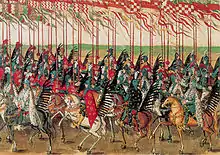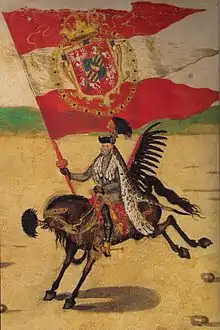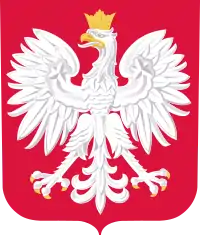Polish hussars
The Polish hussars (/həˈzɑːr/, /həˈsɑːr/, or /hʊˈzɑːr/; Polish: Husaria [xuˈsarja]), or Winged hussars, were one of the main types of Polish cavalry in Poland and in the Polish–Lithuanian Commonwealth between the 16th and 18th centuries.
| Polish hussars | |
|---|---|
 | |
| Active | 1503–1776 |
| Allegiance | |
| Type | Heavy shock cavalry |
| Role | Standing professional military |
| Nickname(s) | The Angels of Death |
| Motto(s) | Amor Patriae Nostra Lex (Love of the fatherland is our law) |
| Colors | Red and white |
| Equipment | Burgonet, lance, mace (bludgeon), hatchet, sabre |
Modelled on the Hungarian hussars, the early hussars were light cavalry of exiled Balkan warriors who were sent to Poland as mercenaries. Following the military reforms of king Stephen Báthory in the second half of the 16th century, the hussar unit was adopted by the Polish military and transformed into a heavily armoured shock cavalry. The husaria banners and units participated in the largest cavalry charge in history at the Battle of Vienna in 1683 and were the elite of Polish cavalry until their disbandment in the 1770s.
History

Hussars originated in mercenary units of exiled Serbian warriors.[1] Serbian lancers, also called Racowie, were used to counter Ottoman sipahi and deli cavalry.[2] The oldest mention of hussars in Polish documents date to 1500, although they were probably in service earlier.[3] In the 15th century, light hussars based on those of Hungarian King Mathias Corvinus were adopted by some European armies to provide light, expendable cavalry units. The Polish Hussars were originally based on the Hungarian Hussars.[1] The development of light cavalry in the Polish army in the 16th century was partly modeled after the Serbian light cavalry that appeared in Corvinus' army.[4]

Initially the first hussar units in the Kingdom of Poland were formed by the Sejm (Polish parliament) in 1503, which hired three banners of Hungarian mercenaries. Soon, recruitment also began among Polish citizens. Being far more expendable than the heavily armoured lancers of the Renaissance, the Serbian-Hungarian hussars played a fairly minor role in the Polish Crown victories during the early 16th century, exemplified by the victories at Orsza (1514) and Obertyn (1531). During the so-called "transition period" of the mid-16th-century, heavy hussars largely replaced armoured lancers riding armoured horses, in the Polish Obrona Potoczna cavalry forces serving on the southern frontier.

The true "winged hussar" arrived with the reforms of the King of Poland and Grand Duke of Lithuania Stephen Bathory in the 1570s and was later led by the King of Poland and Grand Duke of Lithuania John III Sobieski. The hussars were the leading, or even elite, branch of cavalry in the Polish army from the 1570s until 1776 when their duties and traditions were passed on to the Uhlans by a parliamentary decree. Most hussars were recruited from the wealthier Polish nobility (szlachta). Each hussar towarzysz ("comrade") raised his own poczet or lance/retinue. Several retinues were combined to form a hussar banner or company (chorągiew husarska).
Over the course of the 16th century, hussars in Hungary became heavier in character: they abandoned wooden shields and adopted metal-plated body armour. When Bathory was elected King of Poland and later accepted as a Grand Duke of Lithuania in 1576, he reorganized the hussars of his Royal Guard into a heavy formation equipped with a long lance as their main weapon. By the reign of Bathory (1576–1586), the hussars had replaced medieval-style lancers in the Polish Crown army, and they now formed the bulk of the Polish cavalry. By the 1590s, most Polish hussar units had been reformed along the same "heavy" model. These heavy hussars were known in Poland as Husaria.
With the Battle of Lubiszew in 1577, the 'Golden Age' of the Husaria began. Between then and the Battle of Vienna in 1683, the Hussars fought many battles against various enemies, most of which they won. In the battles of Lubiszew in 1577, Byczyna (1588), Kokenhausen (1601), Kircholm (1605), Kłuszyn (1610), Chocim (1621), Martynów (1624), Trzciana (1629), Ochmatów (1644), Beresteczko (1651), Połonka (1660), Cudnów (1660), Chocim (1673), Lwów (1675), Vienna (1683), and Párkány (1683), they proved to be the decisive factor against often overwhelming odds. For instance, in the Battle of Kluszyn during the Polish–Muscovite War, the Russians outnumbered the Commonwealth army 5 to 1, yet were heavily defeated.
The role of the Hussar evolved into a reconnaissance and advanced scout capacity. Their uniforms became more elaborate as their armour and heavy weapons were abandoned. In the 18th century, as infantry firearms became more effective, heavy cavalry, with its tactics of charging into and breaking infantry units, became increasingly obsolete and hussars transformed from an elite fighting unit to a parade one.
Instead of ostrich feathers, the husaria men wore wooden arcs attached to their armour at the back and raising over their heads. These arcs, together with bristling feathers sticking out of them, were dyed in various colours in imitation of laurel branches or palm leaves, and were a strangely beautiful sight to behold ... – Jędrzej Kitowicz (1728–1804).[5][6]
The Hussars were famous for their huge "wings", a wooden frame carrying eagle, ostrich, swan or goose feathers. In the 16th century, characteristic painted wings or winged claws began to appear on cavalry shields. The most common theory is that the hussars wore the wings because they made a loud, clattering noise which made it seem like the cavalry was much larger than in reality and frightened the enemy's horses; however, such sounds would be impossible to hear in battle. The wings (or wing) was mostly used to block the back of the rider from swords or protect them from getting thrown off their horse by Tatar riders.
Tactics

The hussars represented the heavy cavalry of the Commonwealth. The Towarzysz husarski (Companion) commanded his own poczet (kopia) consisting of two to five similarly armed retainers and other servants (czeladnicy) who tended to his horses, food, supplies, repairs and fodder and often participated in battle. His 'lance' was part of a larger unit known as a banner (chorągiew). Each banner had from 30 to over 60 kopia. The commander, per his contractual obligation, was called "rotmistrz", while the de facto commander was often the porucznik (lieutenant). There was also one chorąży (ensign) who carried the banner's flag ("znak" or "chorągiew") and could command the banner when the porucznik was unable to. Each banner had one rotmistrz kopia that was larger than its other lances; this included trumpeters, and musicians (kettle drummers, more trumpeters etc.). There were other towarzysze with duties (keeping order, helping with manoeuvres) within the banner during battle, but their functions are rather poorly understood.
The Polish hussars' primary battle tactic was the charge. They charged at and through the enemy. The charge started at a slow pace and in a relatively loose formation. The formation gradually gathered pace and closed ranks while approaching the enemy, and reached its highest pace and closest formation immediately before engagement. They tended to repeat the charge several times until the enemy formation broke (they had supply wagons with spare lances). The tactic of a charge by heavily armoured hussars and horses was usually decisive for nearly two centuries. The hussars fought with a long lance, a koncerz (stabbing sword), a szabla (sabre), set of two to six pistols, often a carbine or arquebus (known in Polish as a bandolet) and sometimes a warhammer or light axe. The lighter, Ottoman-style saddle allowed for more armour to be used by both the horses and the warriors. Moreover, the horses were bred to run very fast with a heavy load and to recover quickly. These were hybrids of old, Polish equine lineage and eastern horses, usually from Tatar tribes. As a result, a horse could walk hundreds of kilometres loaded with over 100 kilograms (warrior plus armour and weaponry) and instantly charge. Also, hussar horses were very quick and maneuverable. This made hussars able to fight with any cavalry or infantry force from western heavy cuirassiers to quick Tatars. There was a death penalty for selling a husaria horse (sometimes the horses were referred to as "tarpan") to someone outside of Polish–Lithuanian Commonwealth.[7]
Armour and weaponry
 Hussar half-armour from the mid-17th century, National Museum in Kraków.
Hussar half-armour from the mid-17th century, National Museum in Kraków. Hussar armour, dating to the first half of the 17th century, Polish Army Museum in Warsaw.
Hussar armour, dating to the first half of the 17th century, Polish Army Museum in Warsaw. Scale armour of King John III Sobieski.
Scale armour of King John III Sobieski. Polish hussar sabre (Polish "szabla")
Polish hussar sabre (Polish "szabla")
The hussars' towarzysz were required to provide the arms and armour for themselves and their retainers, except for the lance which was provided by the King. Each lance's horses also came at each towarzysz husarski's expense. During their heyday, 1574–1705, winged hussars carried the following arms and armour:
The 'kopia' lance was the main offensive weapon of the hussar. The lances were based on the Balkan and, finally, Hungarian lances, but Polish lances could have been longer and, like their predecessors from the Balkans and Western Europe, they were hollowed, with two halves glued together and painted, and were often richly gilded. They were commonly made from fir-wood, with the lance point being made from forged steel. They had a gałka, a large wooden ball which served as the handle guard. The hussar's lances usually ranged from 4.5 to 6.2 metres (15 to 20 ft) in length and were provided by the King or the banner's owner, not by the regular soldiers. A large 'silk'/taffeta proporzec pennon was attached to the lance below the point. Another type of lance, known as the demi-lance or kopijka, and was 3 to 3.6 metres (9.8 to 11.8 ft) long and was used against the Tatars and Turks in late-17th-century wars.

The Towarzysz husarski carried underneath his left thigh an Eastern-derived koncerz estoc (up to 1.5 metres (4.9 ft) in length) and, often, a palasz (a type of broadsword) under his right thigh. The szabla sabre was carried on the left side, and several types of sabres were known to winged hussars, including the famous szabla husarska.
Winged hussars sometimes carried additional weapons, such as "nadziak" type of war hammers and battleaxes. Towarzysz husarski carried one or two wheellock (later flintlock) pistols in the saddle holsters, while retainers also might have carried a pistol or light wheellock arquebus or carbine; from the 1680s a carbine for retainers was mandatory.
Individual hussar towarzysz may possibly have carried a Tatar or Turkish reflex bow with arrows in a quiver, especially after the mid-17th century, when many 'pancerny' companions became hussars, and some sources of the late 17th century note the existence of bows amongst the hussar companions. During the first half of the 18th century, while in non-military attire, the hussars' companion carried a bow in a bow case to denote his military status. Yet bows in bow cases were carried by all cavalry officers of the National Army until the reforms of the 1770s, including Uhlan units in the Saxon service.
At the height of their prowess, from 1576 to 1653, hussar armour consisted of a Polish variant of the szyszak Oriental Turkic-originated helmet with a hemispherical skull, comb-like, Western morion 'cheekpieces' with a heart-shaped cut in the middle, neck-guard of several plates secured by sliding rivets, and adjustable nasal terminating in a leaf-shaped visor. Szyszak and kettle hat helmets for the lower rank (retainers) were often blackened as was their armour. A cuirass (breast plate), back plate, gorget, shoulder guards and of the Great Steppe, Western vambraces with iron glove and later, during the 1630s, the Persian-originated karwasz vambrace, for forearm protection. Towarzysz also could wear tasset hip, cuisse thigh and poleyn knee protection, underneath a thigh-length coat of mail or specially padded coat with mail sleeves. Retainers usually wore less expensive and older armour, often painted black, and, after the 1670s, might have no cuirass, according to some sources.
Karacena Sarmatian armour (of iron scales riveted to a leather support) might have consisted of a scale helmet, cuirass, gorget, leg and shoulder protection and became popular during the reign of King John Sobieski, but perhaps due to costs and weight, remained popular mostly with the winged hussar commanding officers.
Their armour was light, usually around 15 kilograms (33 lb), allowing them to be relatively quick and for their horses to gallop at full speed for long periods. Albeit from the 1670s onwards, chain-mail was used when fighting the Tatars in the southern part of the republic. Towarzysz usually wore a leopard (sometimes tiger, jaguar or lion) pelt over his left shoulder, or as often depicted in the surviving Podhorce Castle paintings, he had the exotic pelt underneath his saddle or wrapped around his hips. Wolf, brown bear and lynx pelts were reserved for leaders and veterans (starszyzna).

Legacy
The Polish hussars are depicted on the commemorative 200 złotych gold coin. The badge of the Polish Army's 1st Armoured Division is inspired by the armour of the Winged Hussars.
In 2016, the Swedish Metal band Sabaton wrote the song "Winged Hussars" for their album The Last Stand. The song is about the Battle of Vienna in 1683 and the Hussars' charge which helped defeat the Ottomans.
See also
References
- Nolan, Cathal J. (2006). The Age of Wars of Religion, 1000-1650: An Encyclopedia of Global Warfare and Civilization. Greenwood Publishing Group. p. 428. ISBN 978-0-313-33733-8.
- Warfare in Eastern Europe, 1500-1800. BRILL. 6 January 2012. pp. 7–. ISBN 978-90-04-22198-7.
- Brzezinski 1987, p. 14.
- Nicolle, David; Witold Sarnecki (February 2008). Medieval Polish Armies 966-1500. Men-at-Arms. Oxford: Osprey Publishing. p. 19. ISBN 978-1-84603-014-7.
- Anna Wasilkowska, Husaria the winged Horsemen, Interpress, Warszawa 1998, ISBN 8322326823, p.7-6.
- Jędrzej Kitowicz, Opis obyczajów i dziejów za panowania Augusta III, Bolesław M. Wolff, Petersburg i Mohylew, 1855.
Bibliography
- Zbigniew Bocheński - Ze studiów nad polską zbroją husarską. [w:] "Rozprawy i sprawozdania Muzeum Narodowego w Krakowie" t. VI (1960).
- Brzezinski, Richard (1987). Polish Armies 1569-1696. Osprey Publishing. pp. 14–. ISBN 978-0-85045-736-0.
- Richard Brzezinski, Velimir Vuksic: Polish winged hussar, 1500-1775. Oxford: Osprey, 2006. ISBN 1-84176-650-X.
- Jan S. Bystroń - Dzieje obyczajów w dawnej Polsce, Warszawa 1932.
- Jerzy Cichowski, Andrzej Szulczyński: Husaria. Warszawa: Wydaw. Ministerstwa Obrony Narodowej, 1981. ISBN 83-11-06568-3.
- Piotr Drożdż - Orsza 1518., seria: "Historyczne bitwy", Bellona, Warszawa 2000.
- Galeria „Broń i barwa w Polsce”. Przewodnik, Muzeum Narodowe w Krakowie, Kraków 2004.
- Bronisław Gembarzewski: Husarze: ubiór, oporządzenie i uzbrojenie : 1500-1775. Warszawa: Wydawnictwo Arkadia, 1999. ISBN 83-88055-01-1.
- Krystyna Kaczmarek, Remigiusz Kaczmarek, Romuald Kaczmarek, Jan Sobieski jako żołnierz i wódz we współczesnej mu grafice, cz. 2, "Wychowanie Techniczne w Szkole (z Plastyką)", 2005, nr 2, s. 39-42
- Romuald Kaczmarek, Jan Sobieski jako żołnierz i wódz we współczesnej mu grafice, cz. 1, "Wychowanie Techniczne w Szkole (z Plastyką)", 2005, nr 1, s. 26-29
- Włodzimierz Kwaśniewicz: Leksykon broni białej i miotającej. Warszawa: Bellona, 2003. ISBN 83-11-09617-1.
- Mirosław Nagielski: Relacje wojenne z pierwszych lat walk polsko-kozackich powstania Bohdana Chmielnickiego okresu "Ogniem i mieczem" (1648–1651). Warszawa: "Viking", 1999. ISBN 83-912638-0-0.
- Jan Chryzostom Pasek: Pamiętniki. Warszawa: Państwowy Instytut Wydawniczy, 1987. ISBN 83-06-01577-0.
- Leszek Podhorodecki - Chocim 1621., seria: "Historyczne bitwy", MON, 1988.
- Zuzanna Sawicka: Koń w życiu szlachty w XVI-XVIII w.. Toruń: Wydaw. A. Marszałek, 2002. ISBN 83-7174-839-6.
- Radosław Sikora - Fenomen husarii, Toruń: Duet, 2003, ISBN 83-918712-8-2.
- Radosław Sikora - Kłuszyn 1610. Wyd. I. Warszawa: ERICA, 2010, s. 160. ISBN 978-83-62329-05-2.
- Radosław Sikora - Lubieszów 17 IV 1577, Zabrze: Wydawnictwo Inforteditions, 2005, ISBN 83-89943-05-0.
- Radosław Sikora - Z Dziejów husarii, Warszawa: ERICA, 2010, ISBN 978-83-62329-04-5.
- Radoslaw Sikora, Bartosz Musialowicz - Winged Hussars, BUM Magazine, October 2016.
- Janusz Sikorski (red) - Zarys dziejów wojskowości polskiej do roku 1864, t.1
- Jerzy Teodorczyk - Bitwa pod Gniewem 22.IX – 29.IX. 1626, pierwsza porażka husarii. [w:] "Studia i materiały do Historii Wojskowości", t. XII, Warszawa 1966.
- Robert Szcześniak - Kłuszyn 1610., seria: "Historyczne bitwy". Bellona, Warszawa 2008. (wyd. II)
- Henryk Wisner - Kircholm 1605., seria: "Historyczne bitwy", MON, Warszawa 1987. (wyd. I)
- Zdzisław Żygulski (junior): Broń w dawnej Polsce na tle uzbrojenia Europy i Bliskiego Wschodu. Warszawa: PWN, 1982. ISBN 83-01-02515-8.
- Zdzisław Żygulski (junior): Broń wodzów i żołnierzy. Kraków: Kluszczyński, 1998.
- Zdzisław Żygulski (junior): Husaria polska. Warszawa: "Pagina", 2000. OCLC 830218879.
External links
| Wikimedia Commons has media related to Polish Winged Hussars. |
- Reenactment a Polish reenactment information site
- Polish Hussar Replica vs Antique Understand the difference in Polish hussar Replica & Antique.
- Husaria.us a Los Angeles-based Polish Hussar reenactment group and reference library
- The first Los Angeles based website for this portrayal
- About hussar's armour (Polish)
- Polska Husaria: The Cavalry of the Polish Winged Hussars (video)
